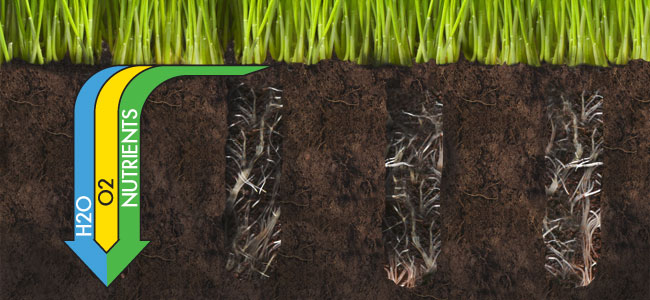Aeration Process

The aeration process is the secret to achieving perfectly green, healthy and lush grass. Indeed all the seeding, watering, fertilizing and tender loving care in the world won’t make a lawn green if essential elements cannot reach the lawn’s root system. The need for aerating arises when compacted soil blocks water, oxygen and nutrients from getting to the lawn’s roots. Compaction can be caused by heavy foot or vehicle traffic or heavy clay soil. Compacted soil not only impedes grass growth due to blocking vital nutrients, but it also hinders the roots from digging deep into the soil. If roots cannot reach the soil’s nutrients, grass will weaken and become susceptible to disease, insects and invasive weeds. In addition to impeding grass growth, compacted soil also leads to unwanted thatch buildup. Aeration helps enhance the production of microorganisms that help organic material decompose properly. By means of poking holes into the soil or removing plugs of soil, aeration exposes grass roots to nutrients and water and gives your lawn much needed breathing room.
Choosing the Right Tool
Most homeowners would agree that the most efficient and time-saving aeration tools are tow-behind spike or plug aerators. Look for aerators that attach easily to your lawn mower or lawn tractor using a hitch pin. Choosing between a spike aerator and a plug aerator really depends on the severity of the compaction issue. Spike aerators normally feature spiked stars or blades that pierce the ground and thatch layer. For lawns with minor to moderate compaction issues, or for aerating prior to seeding or fertilizing, a spike aerator can be the ideal tool. They can be used more frequently in high-traffic areas and don’t interfere with the lawn’s visual appeal. For best results, choose a spike aerator that features a steel tray for adding additional weight (to maximize tine penetration). Tow-behind plug, or core, aerators are ideal for severely compacted or heavy clay soil. The hollow plugging spoons slice into the ground and pull out small “plugs” of soil. These 2-3″ plugs will be deposited on the surface of the lawn as the aerator continues moving. The holes made by a plug aerator allow for rapid root growth and nourishment. It’s important to leave the dirt plugs on the surface of your lawn for a few days, as they contain important microorganisms that feed on thatch. If needed, the plugs can be broken up and raked back into the grass. Just allow them to dry out for a few days prior so they’ll break up easily. If you’re considering a plug aerator, look for individually replaceable plugging spoons. This allows for easy servicing. And just like with spike aerators, you’ll want a sturdy, tough weight tray which will assist in achieving maximum tine penetration in hard soil.
Timing is Everything
Much like dethatching, you’ll want to aerate cool season grasses (Kentucky bluegrass, fescue and ryegrass) in the late summer or early fall. Warm season grasses such as Zoysia, Bermuda, St. Augustine and Buffalo grass should be aerated in the late spring or early summer. If your soil is sandy, you’ll most likely only need to aerate once per year. If you have heavy clay soil, be prepared to aerate at least twice per year. Consider aerating just before fertilizing or seeding as well. The aeration process will help fertilizer or seed to better penetrate the soil, thus providing you the best results. Note that 2-in-1 tools like Aerator/Spreaders allow you to complete both jobs at the same time. Don’t aerate during times of drought and during extreme heat. Aeration during these times not only allows too much moisture to evaporate from the soil, but it also stresses and weakens grass. The ideal time to aerate is after a good overnight shower, or approximately 2-3 days after a heavy rain. If Mother Nature isn’t cooperating with your watering needs, you can always water the day before aerating. Remember, soil needs to be moist but not sopping wet. If you’re not sure if the soil is ready, use a screwdriver to pierce an area of the lawn. If the screwdriver stabs through the soil with just a little resistance, the soil is just right. For more aerating tips, visit www.Brinly.com/BrinlyU
Products for aerating:

